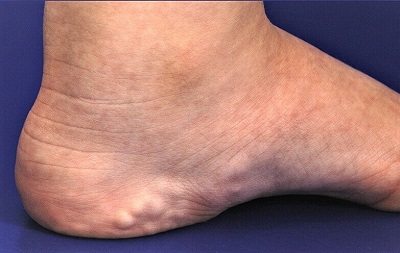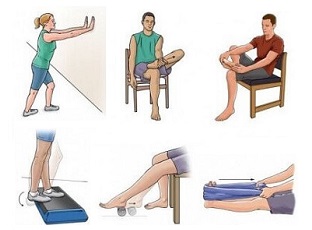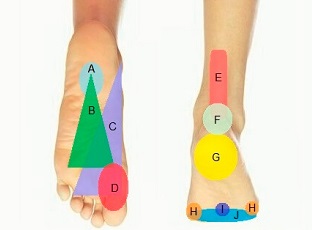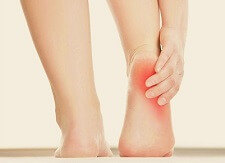- Home
- Diagnosis Guide
- Foot Lumps
- Heel Lumps
Lump On Heel Of Foot
Written By: Chloe Wilson BSc(Hons) Physiotherapy
Reviewed By: FPE Medical Review Board
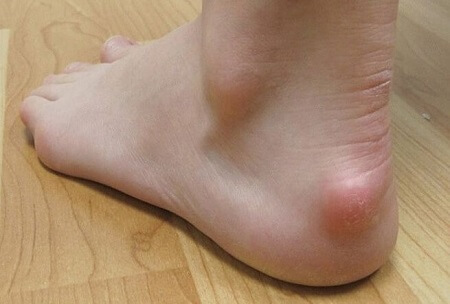
A lump on the heel of the foot is a common problem that can cause pain and affect daily life.
There are a number of possible causes for lumps and bumps on the heel of the foot.
There may be some abnormal bone growth, inflammation or fluid build-up, a mass or a benign tumor.
In most cases, a bump on the heel of the foot is nothing to worry about and will settle down with simple treatment, but any new growth should always be checked out by your doctor.
Here we will look at the different causes of a lump on the heel of the foot, how to work out what one you have and then go on to look at how to treat them. If you are more bothered by pain than swelling, check out the Heel Pain article.
What Causes A Lump On The Heel Of The Foot?
A lump on the heel of the foot may be caused by:
- Bone Damage: a hard lump on the heel of the foot usually indicates excess bone growth or damage e.g. Halgund's deformity, bone spurs, fractures
- Excess Fluid: fluid may build-up and collect to form a soft lump on the heel e.g. bursitis, ganglion cyst, papules
- Medical Conditions: various medical conditions can result in a lump in the heel of the foot e.g. arthritis or diabetes
- Overuse: repetitive overuse of the foot can result in inflammation and thickening of the soft tissues resulting in foot bumps on the heel e.g. tendonitis
Let's start by looking at the most common types of bumps on the heel, the causes and symptoms of each and how to work out what is causing your heel lump. We will then go on to look at the different treatment options for lumps on the heel of the foot.
1. Haglund's Deformity
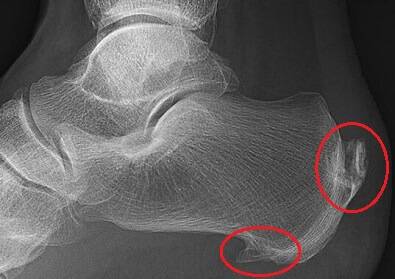
The most common cause of a hard lump on the back of the heel is a Haglund's Deformity, aka Posterior Heel Spur or Pump Bump.
Heel spurs develop when extra layers of bone form on the heel due to a build-up of calcium deposits. This is usually in response to repetitive or excessive friction or stress on the bone.
There are a number of things that can cause a Haglund's Deformity lump on the heel of the foot including:
- Excessive Pressure: e.g. from tight-fitting shoes with rigid backs or high heels can lead to the formation of painful heel bone spurs
- Excessive Friction: e.g. from muscle tightness places a great deal of tension through the part of the bone that the muscle attaches to leading to excess bone growth
- Damage: to the heel bone from an injury or wear and tear can lead to a lump on the heel
Haglund's deformity bone spur lumps on the heel of the foot often cause problems when walking and can be quite uncomfortable when wearing shoes.
Treatment for a painful hard lump on the heel from a Haglund's bone spur usually involves a combination of exercises, orthotics, lifestyle changes e.g. footwear, medication and in some cases surgery.
Bone spurs can also develop underneath the heel, known as inferior heel spurs. They are typically associated with plantar fasciitis and can cause a hard bump underneath the heel. Due to the surrounding soft tissues, you might not be able to feel the bump itself but it can irritate the surrounding soft tissues causing inferior heel pain.
To find out more about these hard lumps in the heel of the foot, including causes, symptoms, diagnosis and treatment, check out the Heel Bone Spurs article.
2. Heel Bursitis
The most common cause of a soft lump on the heel of the foot is heel bursitis.
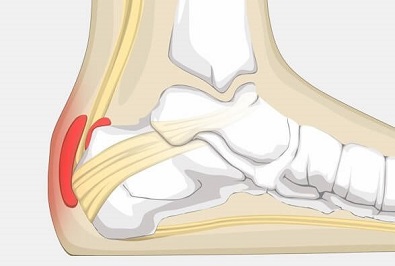
There are a couple of small fluid-filled sacs known as bursa at the back of the heel:
- Retrocalcaneal Bursa: sits between the heel bone and the achilles tendon
- Subcutaneous Calcaneal Bursa: sits just underneath the skin over the top of the achilles tendon
The purpose of the heel bursa is to reduce friction through the achilles tendon, but if there is too much pressure or friction on either bursa then they start to swell.
With heel bursitis, there tends to be a defined pocket of swelling towards the top of the heel. The inflamed bursa is often tender to touch and gets worse with any pressure through the back of the heel e.g. wearing shoes.
A bursitis lump on the heel of the foot typically develops gradually, slowly increasing in size over the course of a few weeks or even months. It is typically caused by repetitive activities e.g. jumping and running, particularly if you suddenly increase your activity levels. Muscle tightness, tight footwear, and certain medical conditions also increase the risk of developing heel bursitis.
Treatment for a bursitis posterior heel lump focuses on reducing pressure and tension through the bursa so that the inflammation can settle. A combination of rest, ice, medication, orthotics and exercises usually works well, but some people may require steroid injections or surgery if their bump on the heel of the foot won’t settle.
Find out more about the common causes, symptoms and treatment options for bursitis lumps on the heel of the foot in the Heel Bursitis article.
3. Achilles Tendonitis
Another really common cause of a painful lump on the back of the heel is Achilles tendonitis. The Achilles tendon connects the calf muscle to the heel bone and is very prone to inflammation.
Achilles tendonitis can develop in a couple of different locations by the heel:
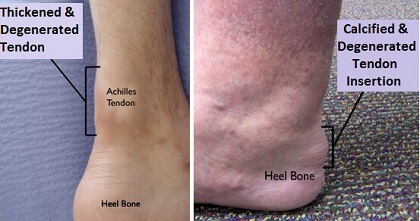
- Insertional Achilles Tendonitis: where the tendon attaches to the back of the heel bone
- Non-Insertional Achilles Tendonitis: at the tendons narrowest point approximately 2-4cm above the ankle joint
Achilles tendonitis usually develops due to a combination of overuse, overtraining, muscle imbalance and altered foot biomechanics. Sudden increase in activity levels such as taking up a new sport can often lead to Achilles irritation.
In the early stages of Achilles tendonitis, there is typically a burning pain in the lower calf and heel region which gets worse with activity. There may not be any obvious heel swelling to start with but over time, the tendon starts to thicken, resulting in a lump on the heel of the foot.
The most obvious sign of Achilles tendonitis is thickening in the tendon which is often very tender to touch. Pain tends to be focused around the area of inflammation but may radiate to the calf and foot. A lump on the heel of the foot from Achilles tendonitis is often really painful first thing in the morning when you first get up but then slowly eases once you start moving around, unless you overdo things.
There are lots of things you can do to treat a lump on the heel of the foot from Achilles tendonitis and you can find out all about the causes, symptoms, diagnosis and treatment options in the Achilles Tendonitis Treatment article.
4. Piezogenic Papules
If you have lots of small lumps around the heel of your foot, particularly at the sides, chances are they are piezogenic papules.
Piezogenic papules are soft, skin-coloured bumps that affect people who spend long periods on their feet, or people with connective tissue disorders e.g. Ehlers-Danlos syndrome.
Piezogenic papules develop when fatty tissue herniates through the dermis (inner layer of the skin) into the connective tissue around the heel, resulting in small bumps on the heel of the foot.
They rarely cause any symptoms and are usually left untreated. Occasionally, piezogenic papules may press on nearby blood vessels or nerves in which case they can be treated with rest, orthotics, acupuncture, injections or occasionally surgery.
Find out more about this common cause of small heel lumps in the Piezogenic Papules section.
Other Causes Of Foot Heel Lumps
There are a few other less common causes of a lump on the heel of the foot:
- Plantar Fibroma: if there is a small, pea-sized lump under the heel in the arch of your foot, it could well be a plantar fibroma. Plantar fibromas are small, firm nodules that form in the plantar fascia which extends from the heel bone to the toes. Plantar fibroma foot lumps are usually less than an inch wide and are usually painless, although people often say it feels like they have a small stone in their shoe. Find Out More >
- Ganglion Cyst: small, harmless lump of jelly-like fluid. A foot ganglion may or may not be painful depending on its size and location. They are usually smooth, round or oval and soft and squashy. Ganglion cysts are a common cause of foot lumps but are more often found on the top or bottom of the foot, rather than around the heel. Find Out More >
- Os Trigonum: a small extra piece of bone that can be felt as a small, hard lump at the back of the ankle joint near the achilles tendon. Often only causes problems following an ankle injury or with repetitive plantar flexion movements, typically affecting ballet dancers, runners and football players. Find Out More >
- Xanthoma: Small, soft deposits of fat can build up under the surface of the skin forming firm, defined foot bumps on the heel. Xanthomas are usually pink or yellowish in colour, look slightly waxy and can vary in size. Single nodules may appear or there may be a cluster of foot bumps around the heel. They may be itchy and tender but are rarely painful. Xanthomas are often linked with certain medical conditions such as diabetes, high cholesterol, liver problems, underactive thyroid and certain cancers.
- Plantar Warts: aka verruca vulgaris. Infection from the HPV virus causes small, rough lumps to develop, typically on the weight-bearing areas of the foot. There may be a single lump or a cluster or warts and they are often painful when standing or walking. The most classic feature is tiny black dots in the middle of the lump. Find Out More >
- Synovial Sarcoma: a rare yet serious cause of a lump on the heel of the foot is a malignant tumor, known as a synovial sarcoma. They are rare with an incidence of less than 3 per 100, 000, typically affecting people aged 15-40. In most cases, malignant growths are irregularly shaped and immobile but this isn’t always the case. If your doctor suspects that the lump on your heel is malignant, they will arrange a biopsy.
- Arthritis: There are various different type of arthritis that can cause lumps in the heel of the foot. Rheumatoid arthritis can result in the formation of hard, round rheumatoid nodules anywhere in the foot. Gout foot can lead to painful, swollen joints in the foot due to a build-up of uric acid – most notably affects the big toe.
Lumps and bumps can occur anywhere on the foot and you may also be interest in the following articles:
Diagnosing Bumps On Heel Of Foot
It is really important to get any new lump or swelling on the heel of your foot checked out by your doctor so that you can get an accurate diagnosis and access the right treatment.
In many cases, your doctor will be able to tell what is causing the lump on your heel by examining you and taking your history, but in some cases, they may want to send you for further tests or investigations such as an MRI or CT scan, a biopsy or an x-ray.
How To Treat Foot Bumps On Heel
Treatment for a lump on the heel of the foot will depend on what is causing the bump but may typically include a combination of exercises, activity modification, orthotics, physical therapy, steroid injections or in rare instances, surgery.
You can find out more about the best treatments for different causes of foot heel lumps in the relevant sections for each condition:
- Heel Bone Spur Treatment
- Plantar Fibroma Treatment
- Achilles Tendonitis Treatment
- Heel Bursitis Treatment
- Swollen Foot Treatment
- Piezogenic Papules Treatment
Lump On Heel Of Foot Summary
The most common causes of a lump on the heel of the foot are Haglund’s Deformity, Heel Bursitis, Piezogenic Papules & Achilles Tendonitis.
A hard lump on the heel of the foot is usually from a bone spur.
A bone spur lump on the back of the heel is called a Haglund’s Deformity, whereas a hard bump under the heel of foot is called an inferior calcaneal spur.
A soft lump on the back of the heel may be due to heel bursitis or Achilles tendonitis.
A soft bump under the heel of the foot is usually due to a plantar fibroma or plantar wart.
Bumps around the side of the heel are typically piezogenic papules or xanthomas.
Most foot heel lumps are nothing serious are can be treated at home - treatment will depend on the underlying cause of the lump on the heel of your foot. Bumps can also develop in other parts of the foot - check out the Foot Lumps section to find out more.
You may also be interested in the following articles:
- Heel Pain Causes & Treatment
- Pain On Top Of Foot
- Foot Arch Pain
- Nerve Pain In The Foot
- Foot & Ankle Stretches
- Foot Numbness
Related Articles
Page Last Updated: 20th November, 2024
Next Review Due: 20th November, 2026
